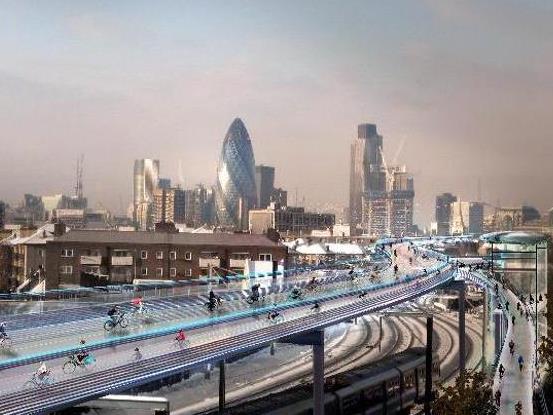Elevated bike routes have been proposed for many cities, including Chicago, Toronto and Sydney. But when the grandest proposal so far – 220 kilometers of bicycle highways in the air above London’s rail network – gets the backing of an architectural firm such as Foster + Partners, the world should take notice.
Not only does Fosters have a reputation for shaping the image of London, in this case the firm has tabled a proposal that deals with a trifecta of ills: congestion, chronic disease and emission. Presumably advocates of segregated bike infrastructure are right behind this?
Actually, many are not, and rushed to the comments section of The Guardian’s architecture and design blog to say so.
Their views are best summarised by cycling bloggers on sites such as Lo Fidelity Bicycle Club, ibikelondon and Next City, who argue SkyCycle will steal funds from simple but effective Dutch style cycle-track development at street level.
A lot of cyclists, it seems, are worried the street would be given over to the car, while they are relegated to an inaccessible level that would make it hard for them to access buildings.

The World Naked Bike Ride in London. The event takes place worldwide in an effort to draw awareness to bike transportation. Image via WikiCommons.
Urban spaces
The roll-out of bike infrastructure now sweeping the world is the most important moment in the production of urban space since the widening of carriageways to make more room for cars. It is also the first such moment in the internet age, when concerned citizens can familiarise themselves with town planning jargon and influence policy. It is important, therefore, that blogs and blog comment trends go under the lens.
Let’s start by scrutinising the idea that SkyCycle will steal funds from street-level works. Consider the magnitude of the project. Some £220 million will be spent just building a 6km test stage from Stratford to Liverpool Street station.
The local road engineers who lobbyists nag for spare change to fix curbs won’t be asked for their pennies as contributions. Sums such as these are committed in boardrooms by people with bigger concerns, such as the city’s commute times and productivity, and capturing land price increases beside the old train line.
Anyone who is worried about SkyCycle taking cyclists away so drivers can have free reign of the street needs reminding of the impact of cross-city tunnels and elevated expressways when these are built to take cars. These projects are always sold as ways to reduce local traffic, but invariably they lead to more driving, meaning more cars than ever before around all the off-ramps.
If designed well, SkyCycle will convert a lot of Londoners to regular riding, who will all have to come back down somewhere. That will mean more, not fewer, street-level cyclists.
How they get down, of course, is an issue. Londoners know from their failed attempt to build a network of elevated walkways back in the sixties that ours is a ground-hugging species. The condition of cycling, though, is a bit different.
For starters it’s faster than walking. Time-wise, therefore, the same access points would seem a lot closer. Cyclists also get to keep their momentum as they start up a ramp, reducing the effort required to change levels.
(We can speculate that London’s elevated walkways could have succeeded were it not for the bi-law prohibiting bikes.)
Bring the bikes back
No city in which generations have passed since cycling was mainstream has been able to bring bike riders back as the Dutch and the Danes did. Known bicycling cities such as Amsterdam, Copenhagen, Groningen and Ferrara are also quite small, comparable to the size of one London borough.
There are lessons from them, of course, that would make cycling more inviting on the neighbourhood scale, but London is a big city whose competitive advantage comes when the members of any household are able to commute between boroughs to pursue highly specialised work, education and interests. Arterial bike routes will reward Londoners with fast, healthy and cheap access to the furthest reach of their mega-city.
Which leaves one question: why aren’t the proposed bicycling highways back-drafted and covered? Modelling by Sustainable Transportation Systems in Colorado points to huge savings in effort for those who aren’t quite as sportive.
A few of us too, would prefer to ride out of the rain, as we get to do on the bus or the train.

Most cyclists would still be impacted by weather factors. Image by markb120 on Flickr.
In the 1996 book The Sex of Architecture Mary McLeod offered an insightful critique of heterotopian spaces (shut-off utopias in the real world, such as SkyCycle).
She argued they always entrench power relations favourable to the white male elite. We’ve always known Foster’s office is blokey; that was the architectural critic Charles Jencks‘ very first criticism of the hi-tech movement, when he started writing against it back in the 1980s.
They can build a great corporate bank, but might need help when the users won’t only be dudes like themselves: Team-Sky wannabes decked out in Rapha.
But problematising the brief can come later. Right now the whole concept risks losing politicians’ and investors’ support because too many cyclists say they don’t like it. London’s size, topography and intergenerational madness for cars means Dutch and Danish history will not be repeated precisely.
Received wisdom from those bicycling nations will need to be mixed with industrial-scale innovation – something the British invented.
The authors do not work for, consult to, own shares in or receive funding from any company or organisation that would benefit from this article. They also have no relevant affiliations.
This article was originally published at The Conversation. Read the original article.
